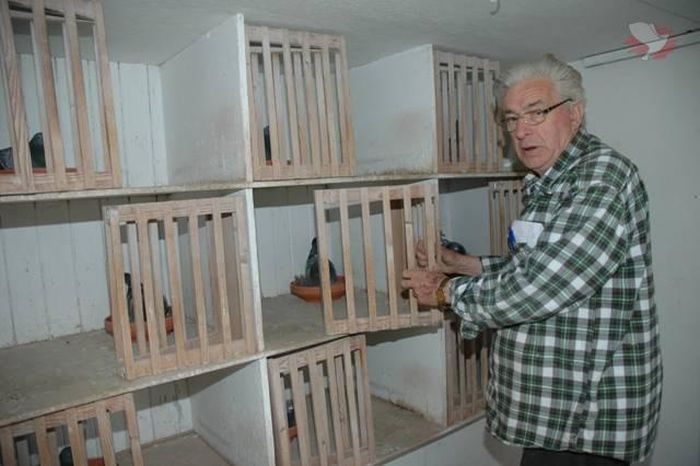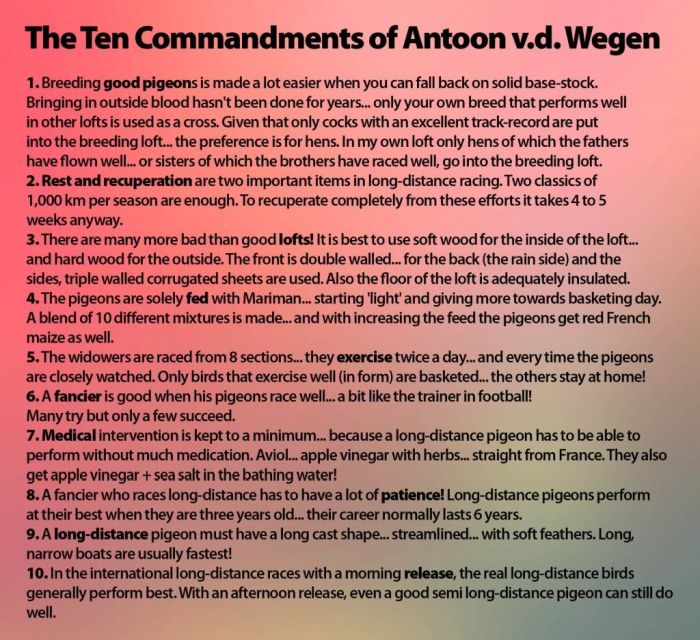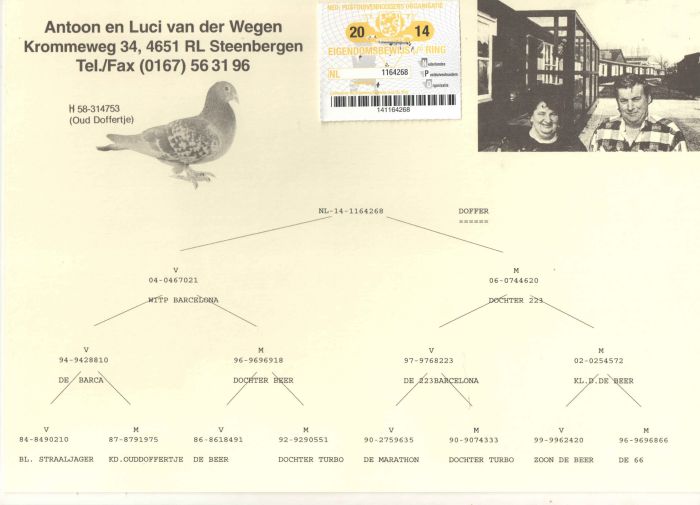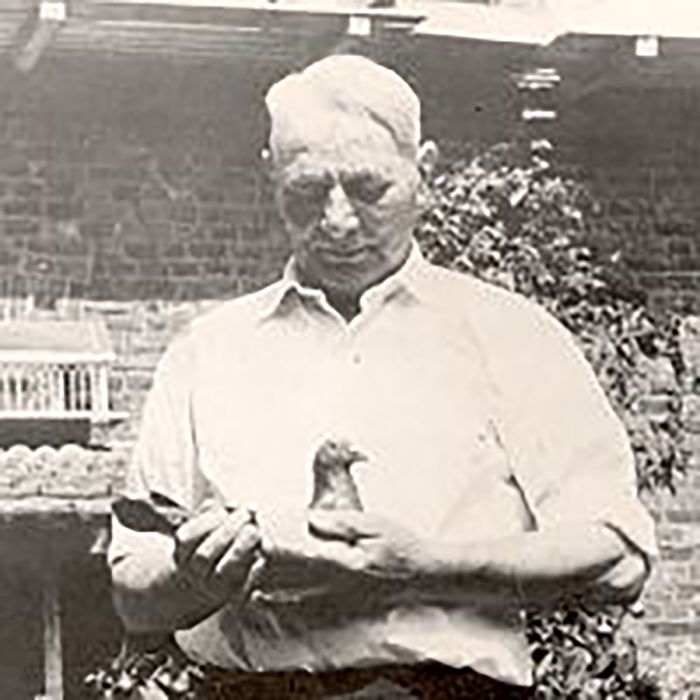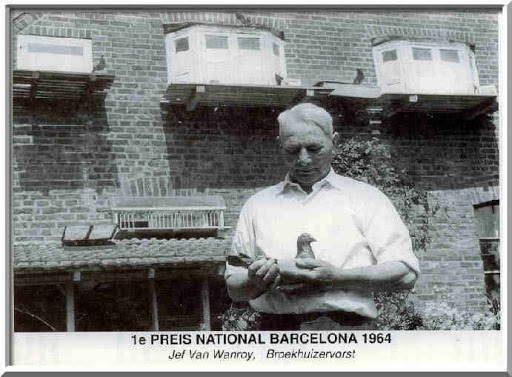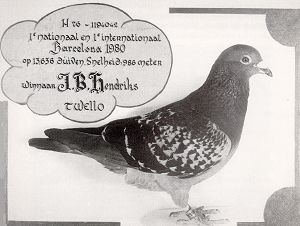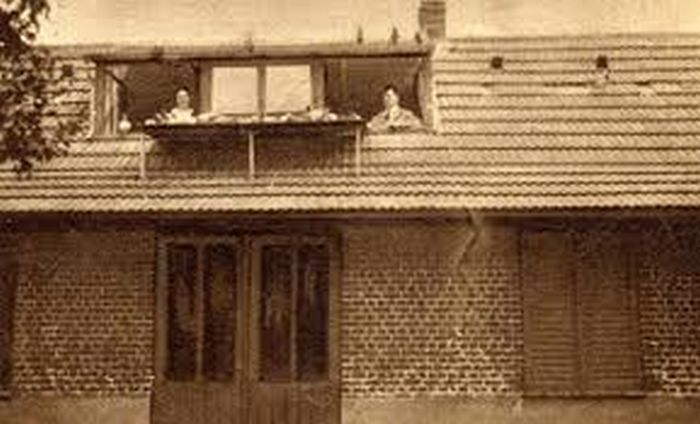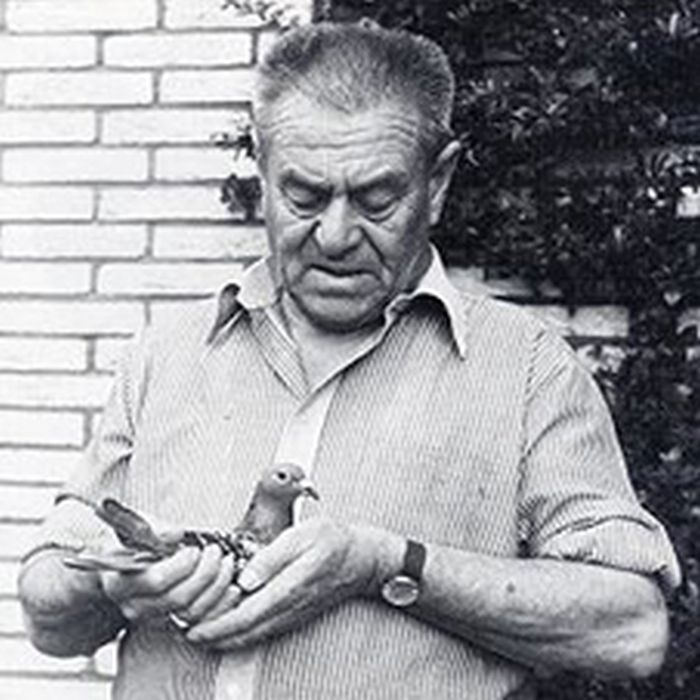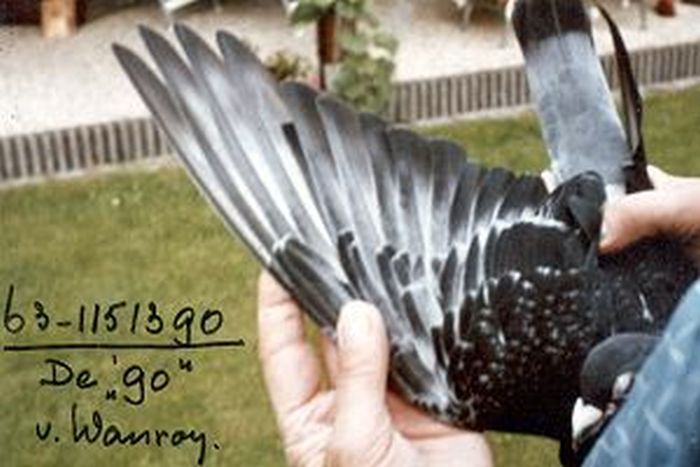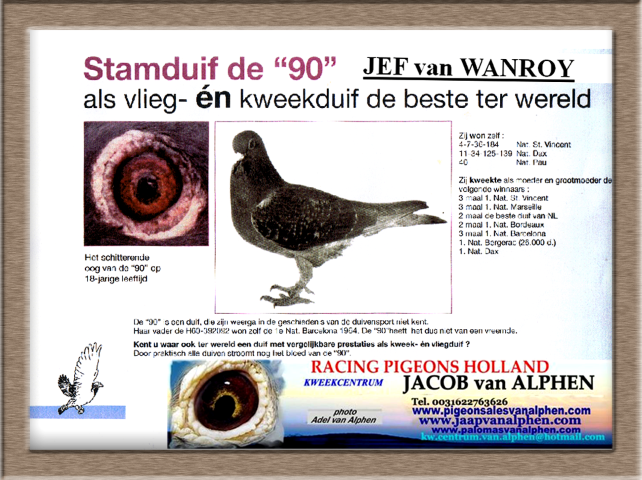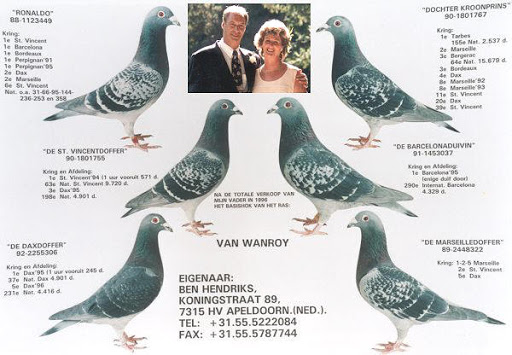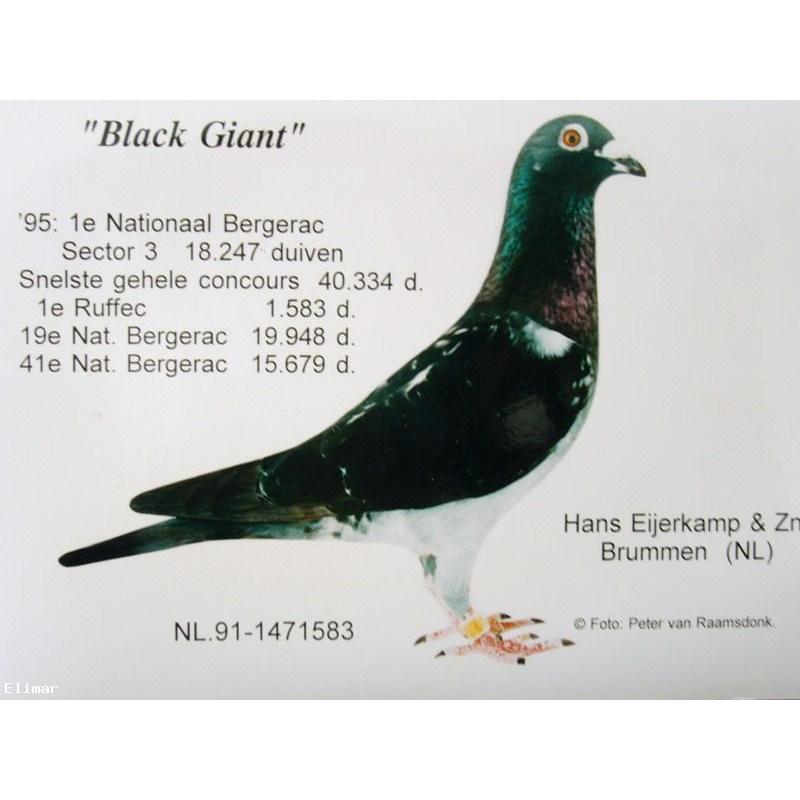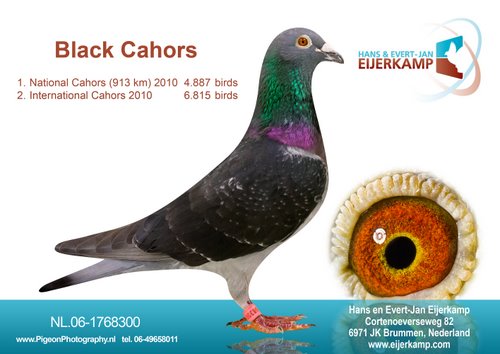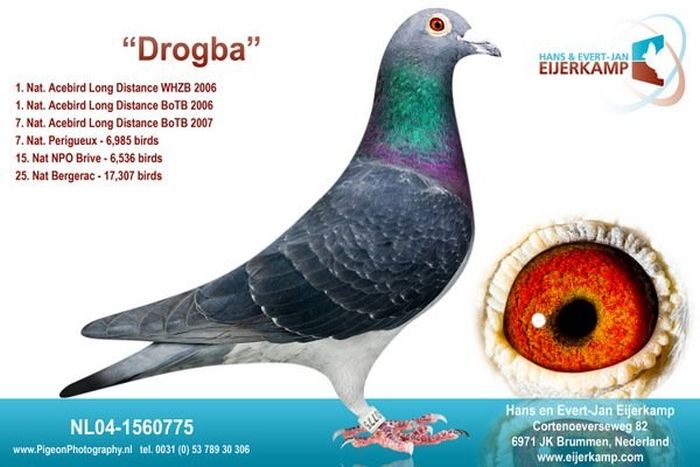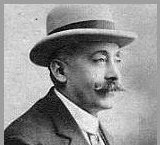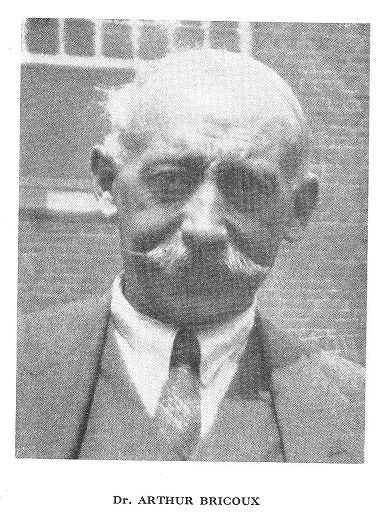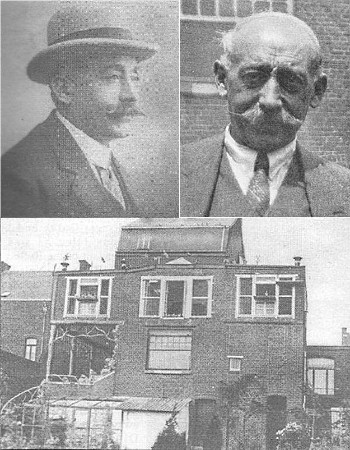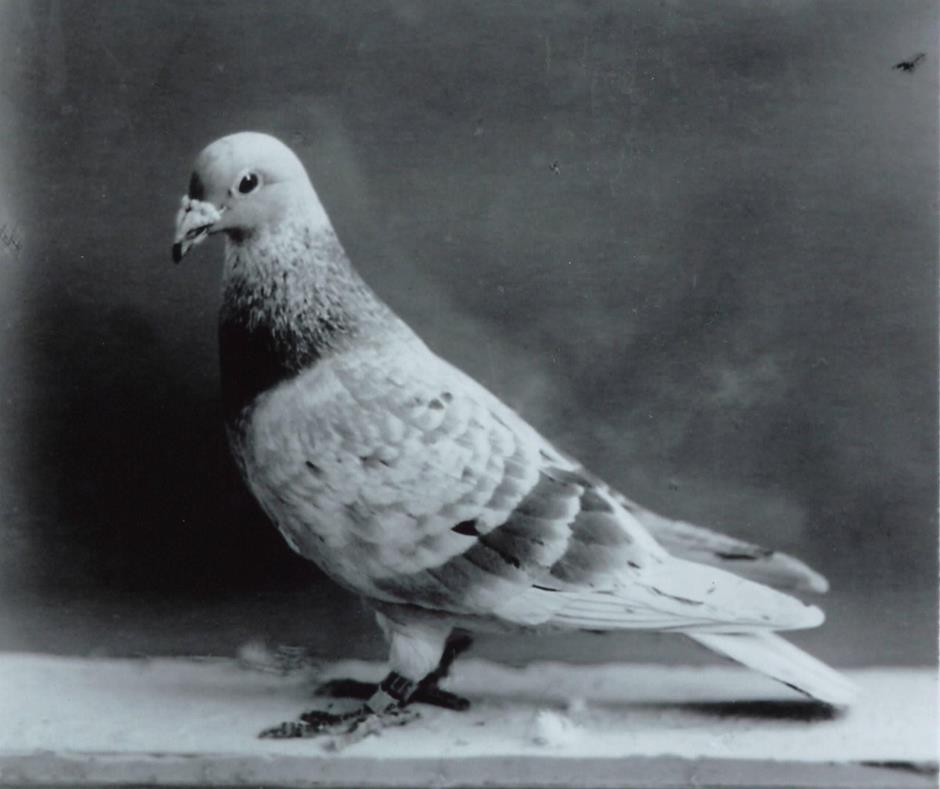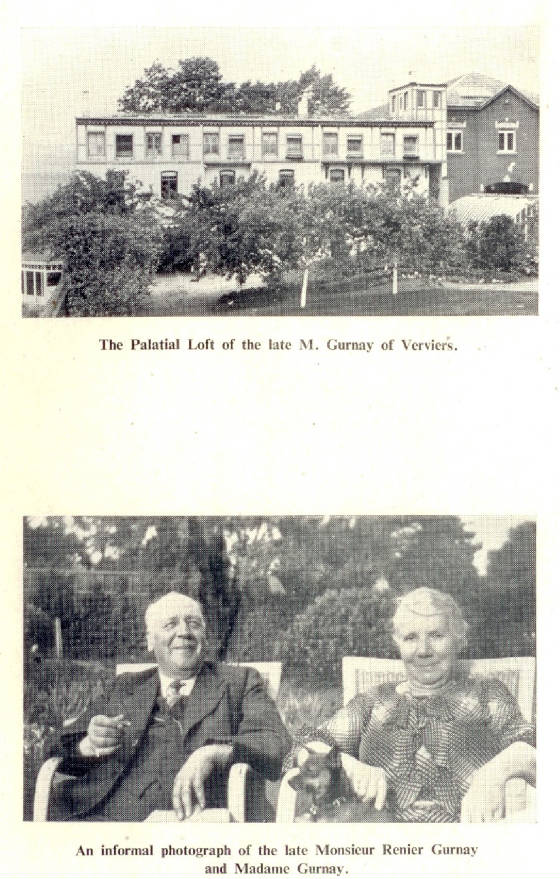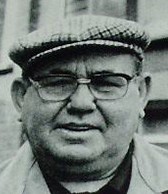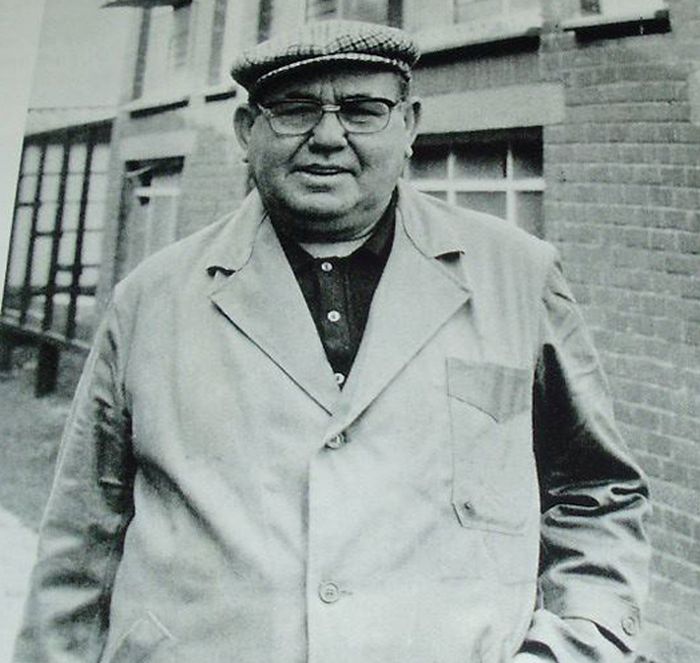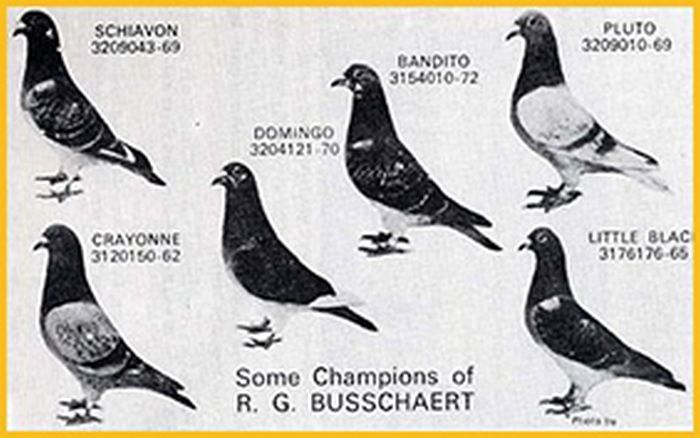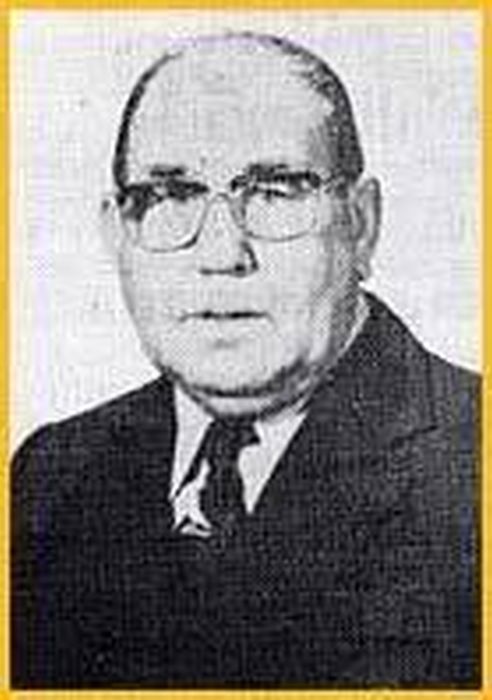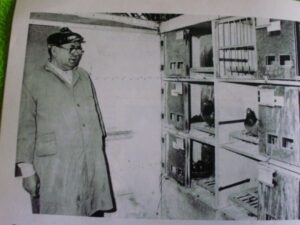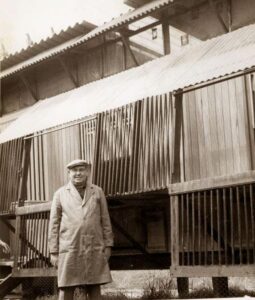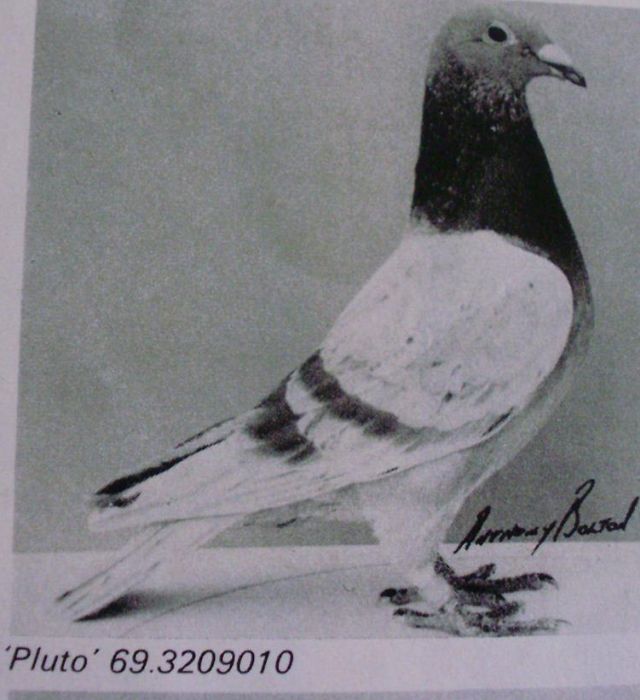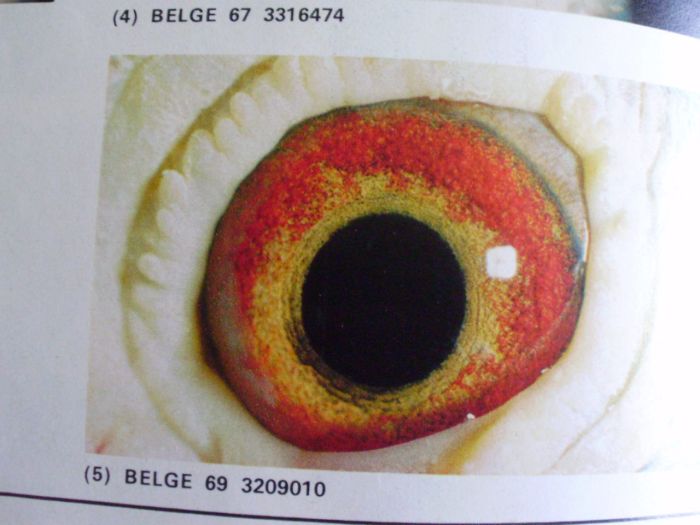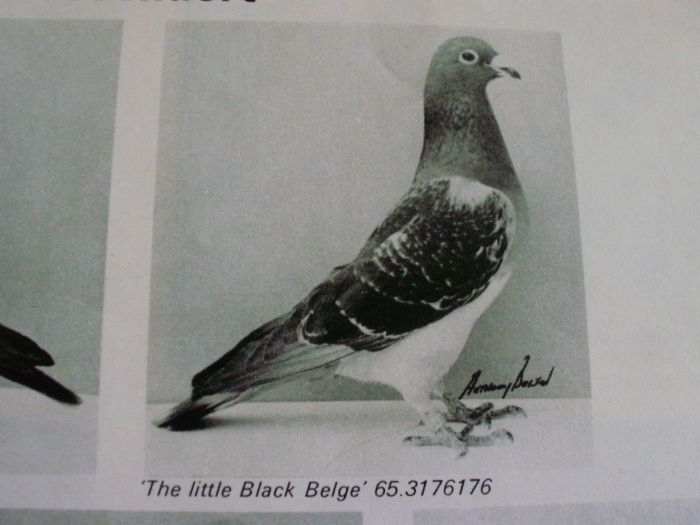Antoon Van der Wegen
The Van Der Wegen family of Racing Pigeons, from Steenbergen in Holland
- Steve O'Dea
- March 24, 2021
- 5:05 pm
Watch, Listen or Read about the Van Der Wegen Racing Pigeon family below here....
 “Antoon never wanted to be in a picture with one particular pigeon. For him they were all champions. Only with ‘Turbo’ (1st National Pau) he posed to show his wing. Antoon only wanted to have composition pictures from his pigeons. As many pigeons with results as possible in one picture as they made the name Van der Wegen famous collectively.”
“Antoon never wanted to be in a picture with one particular pigeon. For him they were all champions. Only with ‘Turbo’ (1st National Pau) he posed to show his wing. Antoon only wanted to have composition pictures from his pigeons. As many pigeons with results as possible in one picture as they made the name Van der Wegen famous collectively.”

The Dutch town of Steenbergen, seems so similar to many towns in the province of North Brabant in the south of the Netherlands. To many pigeon fanciers around the world this town is the spiritual home to the Dutch extreme long distance pigeon. Steenbergen is the source of many outstanding strains and families such as Jan Aarden, Ligtenburg and Van Agatmaal, among others. Obviously there must be something in the air or water of Steenbergen which has produced such giants and greats of the sport. The family we are focusing on today is deserving of equal status of the Aarden family, such has been the success of the strain of distance pigeons built by Adrianus Van der Wegen and his sons (Jac and Antoon).
As Mdm. Luci Van der Wegen said about her late husband (Antoon died 2018) when being interviewed before the clearance sale of the Van der Wegen birds in 2020, “ Antoon was the pigeon fancier, he was always very straight forward, he gave his opinion unsalted and short. He could coach his widowers team like nobody else could.” “Antoon never wanted to be in a picture with one particular pigeon. For him they were all champions. Only with ‘Turbo’ (1st National Pau) he posed to show his wing. Antoon only wanted to have composition pictures from his pigeons. As many pigeons with results as possible in one picture as they made the name Van der Wegen famous collectively.”
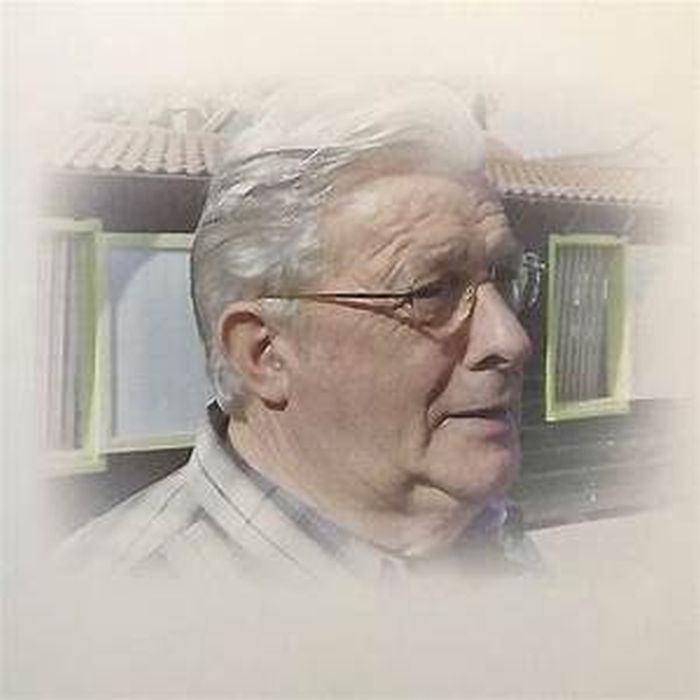
When we attempt to write the story of this wonderful strain of pigeons there are not many articles to refer to. This was mainly because Antoon Van der Wegen didn’t like to be in the spotlight. So much of our account is based upon the article published for that final clearance sale in 2020.
Antoon bought his base breeding mother, a dark hen, at Tinus Van Meer. Tinus moved and that’s why he sold all his pigeons. The dark base hen “Donkere Duivin” had ring number 55-497392 . Her father came from Antoon Stoffelen, who had Aarden pigeons in his loft. The mother came from Rombouts, a hairdresser by profession but another owner of Aarden pigeons. The dark hen showed well in her first races for Antoon (max. 400km). Antoon believed she would be able to do more, together with his father it was decided to race the long distance races. So she was raced first from St. Vincent where she won a prize although not highly placed but she proved she was capable of flying the distance. After that she went to Dax and won the 11th National. A year later she won 5th National Dax. Antoon’s hunger for success with her wasn’t satisfied yet. It was decided to race her again from St. Vincent, this was now the year 1960. The ‘Dark Hen’ unfortunately didn’t return and we will never know what other great birds she would have bred.
In 1958 Antoon Van der Wegen visited the lofts of the local grocery owner Toontje Ligtenberg. After a bit of negotiation, it was decided that Antoon could get a couple of eggs, from any birds in the loft. He chose, and to the marvel of Ligtenberg, Antoon pointed out to the couple of eggs that were in the box at the left top corner of the loft. We are talking of a time when both the racers and breeders were mixed up amongst each other. Lightenberg tried to get out of the deal as this couple of eggs were already promised to someone else, but Antoon stood his ground as a straight speaking man. ‘When we get to choose…we get to choose without any excuses’. So it was agreed and Antoon left with his 2 eggs. From these two eggs he got two cocks. One of the cocks got lost around the loft and the remaining cock was a very small, smart cock who became world famous as ‘Oud Doffertje’ Partly of Aarden and partly of Delbar blood, it was the brother of the famous ’10’ of Toontje Ligtenburg.

Oud Doffertje was paired to “De Donkere duivin” as he was of the smaller type and she was of the bigger type. The pairing of “Oud Doffertje” x “Donkere duivin” was a super success a true golden pair, everything that hatched was winning.
We’re thinking of the “86” (12th, 80th and 96th National St. Vincent – 19th and 34th National Dax) – “De Lamme” winner of 6th Nat. St. Vincent , 7th, 10th and 11th National Dax – “Nestzus De Lamme” (28th and 43rd Nat. St. Vincent). Unfortunately, the “Donkere Duivin” never returned from her last race…who knows what would have come out of this GOLDEN PAIR.
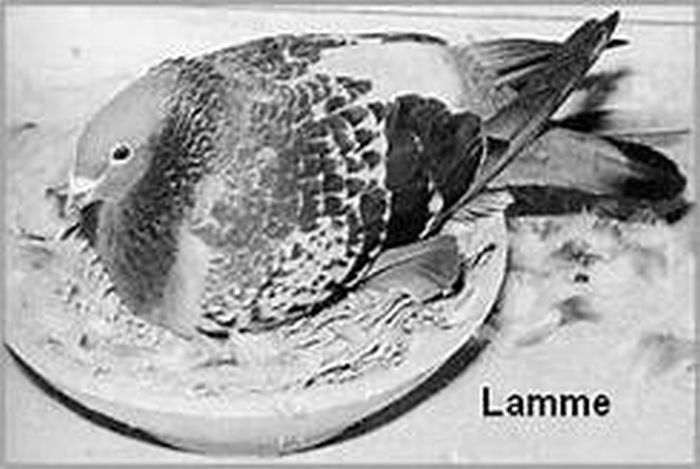
Another hen that gave a lot of joy to Antoon was “De Oude 75” NL57-704975, a half-sister to the “Donkere Duivin”. These hens both had the “Rombouts Hen” as their Dam. After the loss of
“Donkere Duivin”, the “De Oude 75” was paired to “Oud Doffertje” this pairing also had great success.
Known children were “52” (won: 2nd Nat. Bergerac – 35th, 39th, 68th Nat. Dax and 76th Nat. St. Vincent), “De Witpen”, “De Schrale”, “De 74” and “Oud Donkertje”
But real success, internationally recognised success, started with the “Barcelona” (NL65-2023862) The “Barcelona” a super racing cock, that won in ’73, in very hard weather conditions, the 1st National Barcelona against 1,101b and this as an 8 year old ! This was not a one off result, as he had already won 2nd National Dax against 2,969b, 5th National Barcelona against 1,238b. Three weeks before Barcelona he won 14th National St. Vincent against 6,206b.
 “But real success, internationally recognised success, started with the “Barcelona” (NL65-2023862) The “Barcelona” a super racing cock, that won in ’73, in very hard weather conditions, the 1st National Barcelona against 1,101b and this as an 8 year old ! “
“But real success, internationally recognised success, started with the “Barcelona” (NL65-2023862) The “Barcelona” a super racing cock, that won in ’73, in very hard weather conditions, the 1st National Barcelona against 1,101b and this as an 8 year old ! “
Once in the breeding loft he gave his unique genes onwards to his children and grandchildren. His father is the previously mentioned “Lamme” (NL60-252162 – a son to “Oud Doffertje” x “Donkere duivin”) , his mother the “Gruyters-Duivin”. The “Gruyters-Duivin” was bought together with her brother the “Gruyters-Doffer” at the total sale of Huub Gruyters from Helmond in ’64. Huub had pigeons from his good Belgian friend Hector Desmet from Geraardsbergen who he got to know during a spell as a prison of war in WW II. After they were released they went to look for each other and Huub went home with off spring of the famous Desmet pigeons “De Prins” and the “Libourne”.
When the “Gruyters-doffer” was paired to the “Zuster Lamme” (NL60-252161 – a full sister to the 1st nat. Dax), they produced the unrivalled “75-duivin” (67-2057675). This hen was paired over the next 3 years to her grandfather “Oud Doffertje” and the offspring had a very important role in the appearance of the “Van der Wegen strain”. The last heroes, as we noted at the beginning of the report, Antoon passed away in 2018. It’s more than logical that we can’t record recent results but that doesn’t do anything about the breeding qualities this is more than interwoven in the DNA of the Van der Wegen birds.
The last top birds that made Antoon Van de Wegen so very proud are:
“Donkeren Barcelona”, winner of: 25 Nat. Perpignan ‘93 7,580b. 48 Internat. Perpignan 18,447b. 34 Nat. Perpignan ‘91 8,102b. 63 Internat. Perpignan 27,167b. 49 Bergerac 2,488b. 65 Nat. Perpignan 3,448b. 191 Nat. Perpignan ‘89 2,975b. 206 Nat. Perpignan ‘92 6,070b. 222 Nat. Barcelona ‘94 7,767b. 388 Nat. Barcelona ‘93 10,574b. 206 Nat. Perpignan ’92 6,070b. 222 Nat. Barcelona ’94 7,767b. 388 Nat. Barcelona ’93 10,574b.
“De Stek”, winner of: 1 Nat. Dax ’99 4,108b. 19 Internat. Dax ’99 12,880b. 3 Bordeaux ‘98 1,584b. 39 Limoges ’98 1,981b.
“De Turbo”, winner of: 1 Nat. Pau ’88 1,777b. 26 Internat. Pau 5,411b. 12 Nat. Pau ’89 1,972b. 417 Chateauroux 12,388b.
“Den Euro”, winner of: 1 Dax ’95 822b. 3 St. Vincent ‘96 1,821b. 35 Internat. St. Vincent 19,876b. 6 St. Vincent ’95 2,162b. 54 Internat. St. Vincent 25,041b.
“De Barca”, winner of: 18 Barcelona ’00 801b. 184 Nat. Barcelona 7,568b. 71 Nat. Barcelona ’98 6,290b. 164 Internat. Barcelona 24,139b. 345 Nat. Barcelona ’97 7,047b.
“Zoon Marathon”, winner of: 40 Nat. Barcelona ’97 7,047b. 102 Internat. Barcelona 24,908b. 89 Nat. Perpignan 3,815b. 129 Nat. Perpignan 3,785b. 167 Nat. Barcelona 6,290b.
“De Marathon”, winner of: 8 Nat. Barcelona ’93 10,574b. 12 Internat. Barcelona 33,145b.
“De Beer”, winner of: 1 Nat. Marseille ’88 2,087b. “Lucia”, winner of: 6 Internat. Perpignan hens 30 Internat. Perpignan 13,573b. 104 Nat. St. Vincent 27,296b. 212 Nat. Barcelona 7,243b.
“De Perpignan”, winner of: 2 Nat. Perpignan ’90 3,242b. 7 Internat. Perpignan 10,444b. 25 Nat. Barcelona 5,451b. 47 Internat. Barcelona 21,194b. 106 Nat. Marseille 2,087b.
“Witpen Barcelona”, winner of: 1 Barcelona ’08 688b. 10 Nat. Barcelona 7,073b. 28 Internat. Barcelona 23,708b. 36 Nat. Narbonne 2,563b. 178 Nat. Perpignan 5,294b. 225 Nat. Perpignan 6,507b. 333 Nat. Perpignan 5,622b. 508 Nat. Barcelona 8,042b.
The Van der Wegen lofts have achieved 1st Nationals from Barcelona, Dax, Pau, Marseille (and Dax with the Z.L.U).
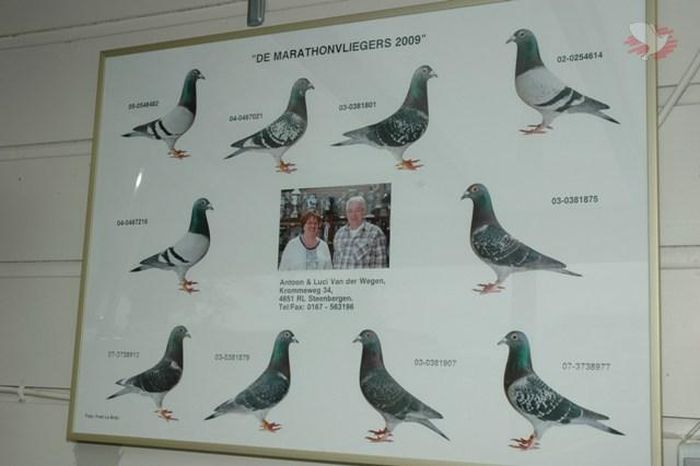
A fantastic Career!
3 x winner Europa Cup
1 x winner Europa Marathon
1st West European Super Marathon
2 x 1st National Marathon
4 x ‘Keizer’ of the super long distance ZLU
2 x Grand Prix ZLU
General ZLU
4 x Club der Azen
1st National Pau
1st National Marseille
1st National Dax ZLU
1st National Barcelona 1973
2 x International Kampioen 1 + 2 nominated IFC 4000
1st Internationaal Kampioen 10 nominated IFC 4000
1st Pau 1 + 2 + 3 nominated IFC 4000
1st Barcelona 1 + 2 nominated IFC 4000
As for their contribution to the successes of others the following list shows the percentage blood wise from some winners in national and international races:
H.Brinkman, Tuk 1st Nat.St.Vincent 100% Van der Wegen
H.Hazelaar, Zutphen 1st Nat Ruffec 100% Van der Wegen
W.Coenen, Nuth 1st Nat.Barcelona 100% Van der Wegen
J.Buurma,Peize 1st Nat.Dax 100% Van der Wegen
Van der Wegen, Steenbergen 1st Nat.Barcelona 100% Van der Wegen
Van der Wegen, Steenbergen 1st Nat.Dax 100% Van der Wegen
Van der Wegen, Steenbergen 1st Nat.Pau 100% Van der Wegen
Van der Wegen, Steenbergen 1st Nat.Marseille 100% Van der Wegen
Van der Wegen, Steenbergen 1st Nat.Dax Z.L.U. 100% Van der Wegen
L.Hoogervorst, Vrouwenakker 1st Nat.Perpignan 100% Van der Wegen
Ron.Van de Werff, Westzaan 1st Nat.St.Vincent 100% Van der Wegen
A.Simons, Roosteren 1st Nat.Perpignan 75% Van der Wegen
Th.Crommentuyn, Velden 1st Nat.St.Vincent 75% Van der Wegen
Th.Crommentuyn, Velden 1st Nat.Pau 75% Van der Wegen
Bakker & Zn, Poortugaal 1st Nat.Perpignan 75% Van der Wegen
L.Smid, Goes 1st Nat.Perpignan 75% Van der Wegen
C.Blokdijk, Hoorn 1st Nat.St.Vincent (S2) 75% Van der Wegen
D.Barberio, Weert 1st Internat.Marseille (H) 75% Van der Wegen
C.Vanoppen, Alt-Hoeselt 1st Internat.Barcelona 50% Van der Wegen
G.Frazer, Ulft 1st Nat. St.Vincent 50% Van der Wegen
A.Simons, Roosteren 1st Nat.Barcelona 50% Van der Wegen
A.Simons, Roosteren 1st Nat.Marseille 50% Van der Wegen
P.Paulussen, Roosteren 1st Nat.Dax 50% Van der Wegen
Jacob Keun, Donderen 1st Nat.St.Vincent (S4) 50% Van der Wegen
D.Rotman, Musselkanaal 1st Nat.Ruffec (S4) 50% Van der Wegen
P.Van Bergen, De Lier 1st Nat.Dax Z.L.U. 50% Van der Wegen
C.Vertelman Zn, Hoogkarspel 1st Nat.Bergerac 50% Van der Wegen
M.Schuurman, Doorn 1st Nat.St.Vincent (S3) 50% Van der Wegen
J.Torreman, Rockanje 1st Internat.Barcelona 50% Van der Wegen
J.Vercauteren, Schimmert 1st Nat. Soustons 50% Van der Wegen
J.Bruine de Bruin, Aalsmeer 1st Nat Bergerac 50% Van der Wegen.
G.de Jong & Zn, De Heen 1st Nat.Perpignan 50% Van der Wegen.
Cor.Van Dijk, Hagestein 1st Nat.St.Vincent (S3) 50% Van der Wegen
W.en B Terhoeven, Zeist 1st Nat.Tarbes (S2) 50% Van der Wegen
Roger Florizoone, Nieuwpoort 1st Nat.Barcelona 50% Van der Wegen
Flip Steketee, Yerseke 1st Nat.Dax Z.L.U. 50% Van der Wegen
Van Gils de Nijs, Oosterhout 1st Nat.Soustons 50% Van der Wegen
Jelle Outhuyse, Harlingen 1st Nat.St.Vincent (S4) 50% Van der Wegen
Jo. Lardenoy, Maastricht 1st Nat.Barcelona 50% Van der Wegen
G.Keesmaat, Krimpen a/d Lek 1st Nat.Dax 50% Van der Wegen
Cor.Hermans, Geulle 1st Nat.Bordeaux (J.L.) 50% Van der Wegen
P.Boers, Goesbeek 1st Nat.Bergerac 50% Van der Wegen
C.Willigers, Steenbergen 1st Internat.Barcelona 50% Van der Wegen
Hendrix-Meijberg, Heerlerheide 1st Nat.Bergerac 50% Van der Wegen
Frans Molenaar, Ulft 1st Nat.Bergerac 50% Van der Wegen
Biemans, Teteringen 1st Internat.Barcelona 50% Van der Wegen
J.L.Van Roy, Ronse 1st Internat.Barcelona 50% Van der Wegen
P.Schlangen, Kerkrade 1st Nat.Barcelona 25% Van der Wegen
P.Schlangen, Kerkrade 1st Nat.St.Vincent 25% Van der Wegen
Van Zelderen, Aalsmeer 1st Nat.St.Vincent 25% Van der Wegen
Van Zelderen, Aalsmeer 1st Nat.Bergerac 25% Van der Wegen
Vogten-Lardinoye, Maastricht 1st Nat.Marseille 25% Van der Wegen
Wijnands & Zn, Maastricht 1st Nat.Perpignan 25% Van der Wegen
B.Walpot, Steenbergen 1st Nat.Barcelona 25% Van der Wegen
Cor.Hermans, Geulle 1st Nat.Marseille 25% Van der Wegen
Jos Thone, As 1st Nat.Barcelona (H) 25% Van der Wegen
F.Bleylevens & Zn, Simpelveld 1st Nat.Marseille 25% Van der Wegen
Willems-Thone, Eijsden 1st Internat.Barcelona 25% Van der Wegen
Hein.Brasse, Nuth 1st Nat.Pau 25% Van der Wegen
H.de Jonge, Weiteveen 1st Nat.Bergerac (S4) 25% Van der Wegen
H.de Jonge, Weiteveen 1st Nat.Ruffec (S4) 25% Van der Wegen
Harry Faassen, Illikhoven 1st Nat.Marseille 25% Van der Wegen
H.en A Kivit, Vinkel 1st Nat.Dax 25% Van der Wegen
Gebr. Schaschkow, Wiesvillers (Fr) 1st Internat Barcelona 25% Van der Wegen
Van Ouwerkerk-Dekkers,Brasschaat 1st Nat.St.Vincent (JL) 25% Van der Wegen
H.Van Helmond, Vorselaar 1 Nat. Pau 25% Van der Wegen
B.Homma, Balk 1st Nat.St.Vincent (S4) 25% Van der Wegen
With the passing of Antoon Van der Wegen, we have seen once again the passing of a genius. His chosen medium was the art of breeding and preparation of beautiful racing pigeons, bred to fly the extreme long distance discipline and when the final hammer fell A “work of art” of inestimable future value to distance racers was distributed worldwide.
